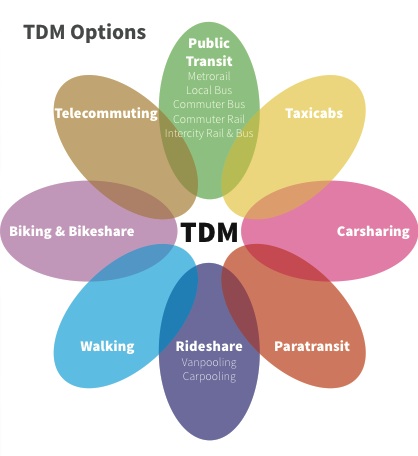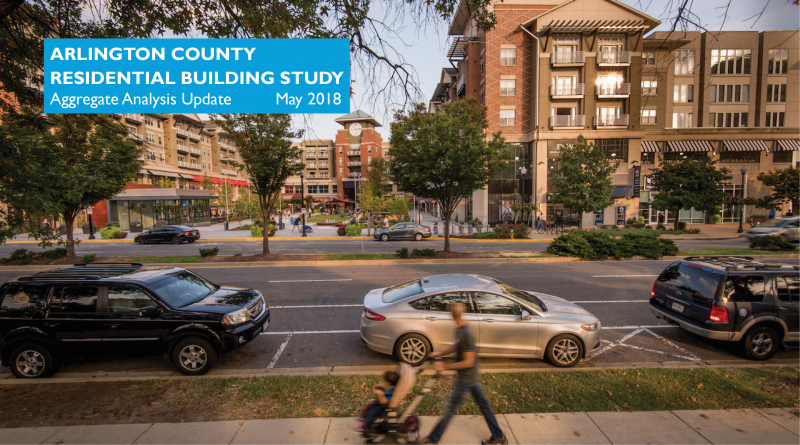Arlington County Residential Building Study: Aggregate Analysis Update. (May 2018). Mobility Lab, with Nelson Nygaard, Weinberger & Associates LLC, and Arlington VA
A recent report by Mobility Lab, in consultation with Nelson Nygaard, Weinberger & Associates LLC, and Arlington, Virginia, details the effectiveness of transportation demand management (TDM) programs by documenting residents’ transportation behaviors in 36 properties in Arlington County (also in Virginia). The report’s findings may be particularly helpful to decision-makers looking to implement TDM or effectively utilize existing TDM or parking requirements, programs and services.

According to Mobility Lab, TDM is a program of “information, encouragement and incentives provided by local or regional organizations to help people know about and use all their transportation options to optimize all modes in the system—and to counterbalance the incentives to drive that are so prevalent in subsidies of parking and roads.” In New Jersey and elsewhere, TDM is under the purview of both public entities, such as local governments, transit agencies, and Transportation Management Associations (TMA), and private organizations, such as Panasonic in Newark.
It is less common for real estate developers to explicitly utilize such programs. In Arlington County, developers applying for special exceptions, either through the site plan process or in keeping with local Form Based Code, may agree to provide TDM strategies to their residents so as to gain more flexibility in development form, use, and density, beyond what is otherwise permitted by right. They may also agree to conduct transportation studies at set intervals to evaluate the transportation patterns of residents, tenants, and visitors. To further the county’s goal of reducing single occupant vehicle (SOV) use, Arlington County first adopted a TDM policy for site plan development in 1990. The researchers utilized information from projects that included TDM strategies to measure the effectiveness of such strategies on the residents’ travel patterns.
The report details the methodology utilized, specifics about each site and the programs provided, and survey responses. Its findings discuss factors contributing to trip generation and building-level travel behavior as well as the characteristics of respondents, their awareness and use of TDM, and their parking and non-commute travel. It concludes with actionable findings.
Highlights
- The researchers found that the actual number of trips made by residents was about half the number of estimated trips projected using the Institute for Transportation Engineers’ Trip Generation Manual (a common planning manual).
- The data demonstrate a clear relationship between higher vehicle ownership and more abundant parking supply. When parking was unbundled (detached from the cost of housing), there was approximately 6% lower auto ownership per unit and 13% lower auto ownership per adult resident. Where it was bundled, SOV use was 12.5% higher for commute trips and 40% higher for non-commute trips. Unbundled parking is the most consistent predictor of lower driving rates.
- A strong relationship exists between parking fees and alternative modes of transportation and non-SOV use. Charging any amount for parking at work increases transit use by 40% and walking/bicycling by 3%, but has almost no impact on carpooling. For those workers who have free parking, driving alone drops from 71% to 28% after a parking charge.
- Residents reported that the following TDM services would likely change their transport mode: discount passes for bus and train, on-site sale of SmartTrip (a rechargeable card used to pay for Metrorail and local bus system fares), a Metrorail shuttle, and discounted or free car-share membership. In some cases, residents who reported they would use a service were not aware that the service was already available in their building.
- A high-quality transit environment is positively correlated with non-SOV use.
For local decision-makers, these findings provide additional evidence supporting the use of TDM strategies, and guidance on the effectiveness of particular TDM strategies, specifically those related to parking such as controlling supply, unbundling parking, and pricing parking at workplaces. The report also highlights the need to adequately communicate the availability of existing TDM services.
Read the full report here.

